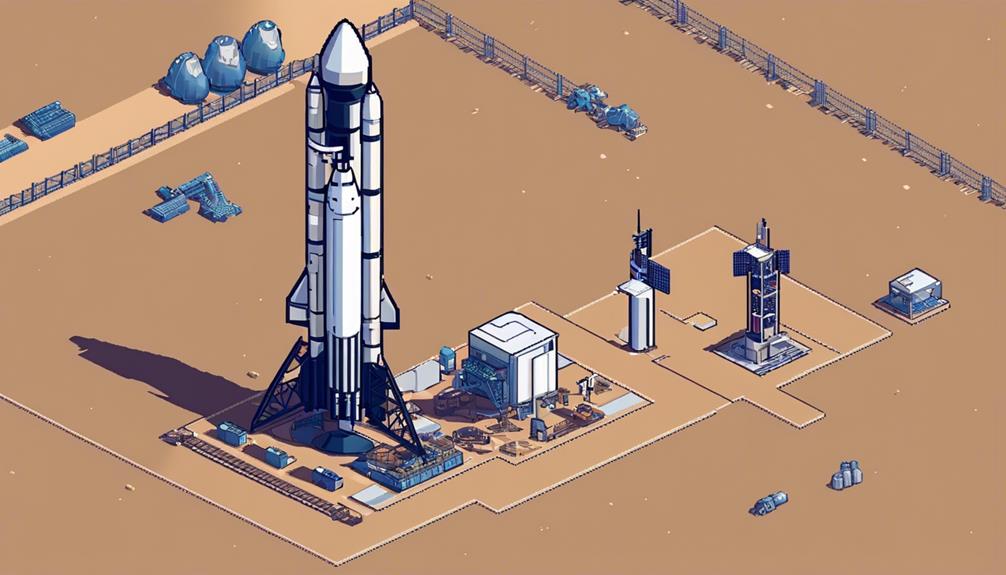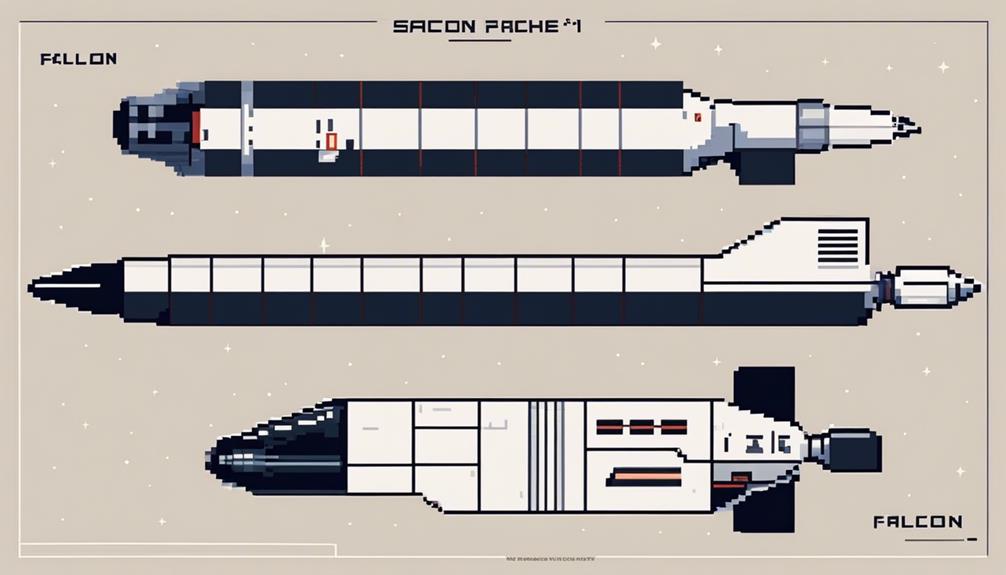SpaceX's Falcon 9 and Falcon Heavy launch vehicles have revolutionized the aerospace industry with their cutting-edge technology and impressive capabilities. From the Falcon 9's enhanced rocket performance to the Falcon Heavy's capacity for carrying substantial payloads, SpaceX's commitment to innovation and efficiency is evident. These launch vehicles have sparked a new era in space exploration, setting new standards for reliability and cost-effectiveness. As we delve deeper into the intricacies of these remarkable vehicles, their potential to redefine the future of space travel becomes increasingly apparent.
Key Takeaways
- Falcon 9 and Falcon Heavy offer diverse payload capacities and cost-effective solutions for various missions.
- SpaceX's emphasis on reusability and efficiency sets a new standard in the aerospace industry.
- Falcon 9's proven track record and Falcon Heavy's enhanced capabilities demonstrate SpaceX's commitment to innovation.
- Starship represents the future of space travel, enabling ambitious missions to Mars and beyond with cost-efficiency.
Falcon 9 Overview

The Falcon 9 launch vehicle, developed by SpaceX, is a two-stage rocket system that has garnered attention for its innovative design and engineering. Utilizing RP-1 kerosene and liquid oxygen as propellants for both stages, Falcon 9 stands out as a versatile and efficient launch vehicle in the aerospace industry. The first stage of Falcon 9 is equipped with nine Merlin engines, providing the necessary thrust for liftoff and initial ascent. In contrast, the second stage features a modified version of the Merlin engine tailored to meet the specific requirements of upper-stage flight.
Since its inaugural orbital mission in June 2010, the Falcon 9 has undergone several upgrades and iterations to enhance its performance and reusability. The Falcon 9 Block-5 variant represents the latest evolution of this launch vehicle, introducing modifications aimed at facilitating easier reuse of the first stage. These enhancements reflect SpaceX's commitment to advancing the state of commercial spaceflight technology and driving down the costs associated with launching payloads into orbit.
Falcon 9 Design Features
Featuring a cutting-edge propulsion system and optimized engine configurations, Falcon 9's design intricacies showcase SpaceX's commitment to innovation in space launch technology. The Falcon 9 is equipped with nine powerful Merlin engines on its first stage, providing the thrust needed for liftoff and initial ascent. This first stage is specially designed for reusability, a groundbreaking feature that enables cost reduction in space missions. Successful landings on drone ships or ground pads mark SpaceX's advancements in achieving sustainable space travel.
In contrast, the second stage of the Falcon 9 is powered by a single modified Merlin engine, tailored for orbital insertion and precise payload delivery. This engine optimization ensures that payloads are deployed accurately into their intended orbits, showcasing SpaceX's dedication to efficiency and reliability. The Falcon 9 utilizes RP-1 kerosene and liquid oxygen as propellants for both stages, a proven combination that balances performance with operational safety.
With a track record of over 300 successful launches, the Falcon 9 has cemented its status as a dependable and cost-effective option in the commercial launch sector. SpaceX's continuous improvements in design and engineering have solidified the Falcon 9 as a leading player in the space industry, setting new standards for innovation and performance.
Falcon 9 Capabilities

Falcon 9's capabilities are distinguished by its impressive payload capacity, reusability features, and high launch success rate. The vehicle's ability to carry varying payloads to different orbits showcases its versatility in meeting diverse mission requirements. Additionally, Falcon 9's track record of successful launches highlights its reliability and efficiency in the commercial, governmental, and crewed spaceflight sectors.
Payload Capacity Comparison
Comparatively, Falcon 9 demonstrates a significant payload capacity advantage with the ability to transport up to 22,800 kg to Low Earth Orbit (LEO) and 8,300 kg to Geostationary Transfer Orbit (GTO). The Falcon 9 Block 5 variant can carry 15,600 kg to GTO and 22,800 kg to LEO. Falcon 9's fairing diameter of 5.2 meters allows for various payload configurations. In comparison, Falcon Heavy, with its three boosters, boasts an impressive capability of lifting up to 63,800 kg to LEO and 26,700 kg to GTO. This larger payload capacity makes Falcon Heavy ideal for heavy satellite launches and deep space missions.
| Vehicle | Payload to LEO (kg) | Payload to GTO (kg) |
|---|---|---|
| Falcon 9 | 22,800 | 8,300 |
| Falcon Heavy | 63,800 | 26,700 |
Reusability Features Overview
With its revolutionary reusable first-stage boosters, Falcon 9 sets a new standard in the realm of space launch vehicles. The Falcon 9 features these reusable first-stage boosters that can achieve propulsive landings on ground pads or drone ships. Successfully completing up to 19 missions, these boosters have demonstrated the practicality of reusability in rocket technology. Falcon 9 made history as the first rocket to achieve propulsive landing in December 2015, marking a significant milestone in space exploration. The reusability of Falcon 9 boosters has significantly reduced launch costs, making space travel more economically viable. Falcon 9 Block 5 boosters are now certified for up to 20 flights, with plans to extend this to 40 flights, emphasizing SpaceX's commitment to long-term reusability goals.
Launch Success Rate
SpaceX's Falcon 9 launch vehicle has established an exceptional track record of mission success, underscoring its reliability and operational efficiency in the realm of space transportation. With 303 successful launches out of 305 missions, Falcon 9 showcases a remarkable launch success rate. The latest iteration, Falcon 9 Block 5, has achieved a perfect record with 240 successful missions out of 240. This impressive performance is a testament to the evolution of Falcon 9, with earlier versions contributing to its current success. The Block 5 boosters, designed for multiple flights with a target of up to 40 missions, emphasize reusability and cost-effectiveness. SpaceX's commitment to efficiency and reliability in space launches is evident through Falcon 9's consistent success rate and reusability milestones.
Falcon 9 Notable Launches

Falcon 9 has accomplished a series of remarkable launches, showcasing its reliability and versatility in various mission profiles.
Notable Falcon 9 Launches:
- Crew Dragon Demo-2: Falcon 9 successfully launched the Crew Dragon Demo-2 mission, a historic flight that marked the return of crewed orbital spaceflight from American soil after nearly a decade.
- GPS III-03: SpaceX's 100th launch was the GPS III-03 mission, where Falcon 9 delivered a next-generation GPS satellite for the U.S. Space Force, demonstrating the vehicle's capability to support critical national security missions.
- ANASIS-II: Falcon 9 launched ANASIS-II, South Korea's first dedicated military satellite, highlighting the Falcon 9's ability to cater to a diverse range of payloads and customers with precision and reliability.
These missions underscore Falcon 9's pivotal role in advancing space exploration and commercial satellite deployment. Additionally, the Crew-1 (Resilience) mission, the first crew rotation mission of NASA's commercial crew program, and the launch of the Sentinel-6 Michael Freilich satellite further solidify Falcon 9's position as a trusted workhorse for a variety of space missions.
Falcon Heavy Overview
Falcon Heavy stands out in the realm of space launch vehicles due to its impressive payload capacity of up to 117,000 pounds to orbit. The utilization of three Falcon 9 first stages, with two acting as boosters, enhances the rocket's capability to deliver heavy payloads. SpaceX's strategic pricing approach with Falcon Heavy aims to offer a cost-effective option for launching large payloads into space, challenging traditional heavy lift launch vehicles.
Falcon Heavy Capacity
With a payload capacity of up to 117,000 pounds, Falcon Heavy stands out as a formidable contender in the realm of super heavy-lift launch vehicles. This impressive capacity allows SpaceX to compete effectively in the heavy-lift launch market, offering a cost-effective solution for customers requiring the transportation of large payloads to orbit. Here are three key points highlighting Falcon Heavy's capabilities:
- Cost-Effective Solution: Falcon Heavy aims to reduce launch costs significantly, making it a more economical choice for heavy payload missions compared to other competitors in the market.
- Direct Competition: Falcon Heavy competes directly with Boeing's Delta IV Heavy, showcasing SpaceX's ability to challenge established players in the super heavy-lift launch vehicle category.
- Market Positioning: By combining high payload capacity with cost-effective operations, Falcon Heavy has solidified SpaceX's position as a leading provider for missions requiring substantial lift capabilities.
Falcon Heavy Launches
Having established Falcon Heavy's impressive payload capacity and cost-effective positioning in the heavy-lift launch market, the focus now shifts to examining the successful launches undertaken by SpaceX's powerful rocket. Falcon Heavy, developed by SpaceX and Elon Musk, first launched in 2018. With the capability to carry payloads of up to 117,000 pounds to orbit, Falcon Heavy competes directly with Boeing Company's Delta IV Heavy. SpaceX's rocket aims to reduce launch costs significantly, targeting one-third the cost of its competitors. Falcon Heavy has demonstrated its versatility by launching large communications satellites, Department of Defense payloads, and even interplanetary missions. These successful missions showcase Falcon Heavy's reliability and potential for various space endeavors.
Falcon Heavy Advantages
Demonstrating enhanced payload capacity and cost efficiency, Falcon Heavy stands out as a formidable contender in the heavy-lift launch vehicle market. With SpaceX at the helm, Falcon Heavy offers a range of advantages over its competitors, including:
- Impressive Payload Capacity: Capable of carrying up to 117,000 pounds to orbit, Falcon Heavy surpasses many other heavy-lift rockets in the industry.
- Cost Efficiency: The primary goal of Falcon Heavy is to reduce the cost of launching payloads into space significantly, aiming to be one-third the cost of competitors like the Delta IV Heavy.
- Competition with Delta IV Heavy: Falcon Heavy competes directly with Boeing Company's Delta IV Heavy rocket, providing a more cost-effective alternative for space missions.
Falcon Heavy Design Features
Falcon Heavy's design incorporates three Falcon 9 first stages, each equipped with nine Merlin engines, to enhance its payload capacity significantly. The side boosters, which are derived from Falcon 9 first stages, play a crucial role in this setup. These boosters are designed to be reusable, either landing back on Earth for refurbishment and relaunch or touching down on drone ships stationed in the ocean. The core stage of Falcon Heavy is essentially a modified and reinforced Falcon 9 first stage. This core stage is optimized to withstand the increased stress and demands of coordinating with multiple boosters during the launch process.
Falcon Heavy Capabilities

Falcon Heavy's impressive payload capacity of up to 64 metric tons to low Earth orbit positions it as a key player in the realm of heavy-lift rockets. Its three Falcon 9 first stages, featuring a total of 27 Merlin engines, contribute to its robust thrust capabilities during liftoff. The rocket's versatility enables it to execute missions ranging from deploying large satellites to embarking on ambitious interplanetary journeys, showcasing its broad orbital insertion capabilities.
Payload Capacity Comparison
With its impressive payload capacity of up to 64 metric tons to low Earth orbit (LEO), SpaceX's Falcon Heavy stands out as a formidable contender in the realm of heavy payload launches. This capability opens up a range of possibilities for various missions, including launching large satellites and enabling interplanetary missions. Furthermore, Falcon Heavy's ability to carry up to 29 metric tons to geostationary transfer orbit (GTO) enhances its utility for deploying payloads to higher orbits. The cost reduction goal of Falcon Heavy adds to its appeal, making it an attractive option for organizations seeking to launch heavy payloads more affordably.
Payload Capacity Comparison:
- Falcon Heavy can lift up to 64 metric tons to LEO.
- It has a capacity of up to 29 metric tons to GTO.
- The rocket is suitable for launching large satellites and diverse payloads.
Orbital Insertion Capabilities
The robust orbital insertion capabilities of the Falcon Heavy launch vehicle position it as a highly versatile and powerful option for a wide range of complex mission profiles. With the ability to carry payloads to geostationary transfer orbit (GTO) and beyond, Falcon Heavy proves its worth for missions requiring heavy-lift capabilities. Its triple-core configuration allows for the launch of heavier payloads to deep space and enables missions to interplanetary trajectories like Mars. The cost-effective solution provided by Falcon Heavy's versatility and adaptability makes it a competitive choice for a variety of space missions.
| Orbital Insertion Capabilities of Falcon Heavy | |
|---|---|
| Payload to LEO | 63,800 kg (140,660 lbs) |
| Payload to GTO | 26,700 kg (58,860 lbs) |
| Deep Space Missions | Yes |
| Interplanetary Trajectories | Yes |
| Configuration | Triple-core |
Falcon Heavy Notable Launches
Notable launches conducted by the Falcon Heavy launch vehicle have demonstrated its capability to deliver diverse payloads into orbit with precision and reliability. The following key launches highlight the impressive capabilities of the Falcon Heavy:
- First Test Flight: In 2018, Falcon Heavy's maiden test flight captivated the world by sending a Tesla Roadster into heliocentric orbit. This successful demonstration showcased the vehicle's immense power and potential for future missions.
- Payload Variety: Falcon Heavy has been instrumental in deploying a range of payloads, including large communications satellites and Department of Defense payloads. Its ability to cater to such diverse missions underscores its versatility and reliability as a launch vehicle.
- Side Boosters Landing: During its first test flight, Falcon Heavy's side boosters executed a flawless landing at Cape Canaveral. This achievement marked a significant milestone in SpaceX's pursuit of reusability and cost-effective spaceflight, setting Falcon Heavy apart as a groundbreaking launch vehicle.
With a design capacity to carry payloads of up to 117,000 pounds to orbit, Falcon Heavy emerges as a formidable competitor to Boeing's Delta IV Heavy, signaling a new era in heavy-lift launch capabilities. As Falcon Heavy continues to evolve and support interplanetary missions, its track record of successful launches positions it as a key player in the future of space exploration.
Falcon 9 Vs. Falcon Heavy

In comparing SpaceX's launch vehicles, Falcon 9 and Falcon Heavy, their distinct design features and performance capabilities reveal significant differences in payload capacity and mission suitability. Falcon 9 is a two-stage launch vehicle powered by nine Merlin engines on the first stage, capable of carrying up to 22,800 kg to low Earth orbit (LEO). In contrast, Falcon Heavy utilizes three Falcon 9 first stages as boosters, enabling it to lift over 63,800 kg to LEO, making it one of the most powerful operational rockets.
The Falcon 9 is primarily utilized for commercial satellite launches and crewed missions to the International Space Station due to its moderate payload capacity. Its first stage is designed for reusability and landing, enhancing cost-effectiveness. On the other hand, Falcon Heavy is suitable for heavier payloads like large satellites and interplanetary missions, expanding mission possibilities requiring heavy lift capabilities. Falcon Heavy's boosters and core stages are also designed for recovery and reuse, further improving cost efficiency in commercial space launches.
While Falcon 9 has proven its reliability through numerous successful missions, Falcon Heavy's higher payload capacity opens up new opportunities for complex space missions. The distinction in payload capacity and reusability between Falcon 9 and Falcon Heavy allows SpaceX to offer a versatile range of launch options catering to various mission requirements in the commercial space sector.
SpaceX's Future Launch Vehicles
SpaceX's forthcoming launch vehicles herald a paradigm shift in space exploration capabilities, exemplified by the innovative design and operational goals of the Starship super heavy lift launch vehicle. The Starship is a fully reusable two-stage rocket that is set to revolutionize space travel with its advanced features. Here are key points about SpaceX's future launch vehicles:
- Versatile Capability: Starship is designed to carry both crew and cargo, marking a significant advancement in enabling human exploration of Mars and beyond. This dual-purpose capability sets it apart from traditional launch vehicles, showcasing SpaceX's ambition for interplanetary travel.
- Propulsion System: Starship will be powered by SpaceX's innovative Raptor engines, utilizing a combination of liquid methane and liquid oxygen as propellants. This choice of propellants offers increased efficiency and performance, aligning with SpaceX's commitment to pushing the boundaries of space technology.
- Cost-Efficiency and Frequency: The development of Starship aims to drastically reduce the cost of space travel while increasing the frequency of missions. By streamlining operations and maximizing reusability, SpaceX intends to make space exploration more accessible and sustainable for future endeavors.
These features highlight the potential impact of Starship in reshaping the landscape of space exploration, with SpaceX planning to transition from the Falcon 9 and Falcon Heavy rockets to the Starship once it proves its reliability and capabilities for space missions.
Conclusion and Further Developments

Upon evaluating SpaceX's current launch vehicles, it becomes evident that their proven success and ongoing advancements set a solid foundation for assessing future developments in space exploration capabilities. The Falcon 9 Block 5, with its impressive track record of over 300 launches and a high success rate, exemplifies SpaceX's commitment to reusability. The certification of Block 5 boosters for multiple flights, aiming for up to 40 flights per booster, underscores the company's emphasis on maximizing the utility of its launch vehicles.
Moreover, the Falcon Heavy, a derivative of three Falcon 9 first stages, offers enhanced payload capacity and cost efficiency for heavy lift missions. SpaceX's operational frequency, as showcased by the 26 successful Falcon 9 launches in 2020 alone, highlights the company's ability to meet a diverse range of mission requirements efficiently.
SpaceX's relentless pursuit of reusability is underscored by the 243 successful re-flights of first-stage boosters, demonstrating a significant milestone in cost-effective space access. As SpaceX continues to innovate and refine its launch vehicles, the industry can anticipate further advancements in operational capabilities, cost efficiency, and overall reliability, solidifying the company's position as a key player in the space exploration domain.
Frequently Asked Questions
What Is the Difference Between Falcon 9 and Falcon Heavy?
In comparing Falcon 9 and Falcon Heavy, notable distinctions include payload capacity, engine configuration, reusability features, cost comparison, launch frequency, and mission flexibility. Falcon Heavy boasts a substantially higher payload capacity than Falcon 9 to low Earth orbit. Engine configuration varies with Falcon 9 having nine Merlin engines on its first stage, while Falcon Heavy integrates 27 across three first stages. Cost, frequency, and mission profiles also differ, catering to diverse launch requirements.
How Many Launch Vehicles Does Spacex Have?
SpaceX currently possesses an impressive fleet of launch vehicles, showcasing the company's commitment to advancing rocket technology and dominating the commercial space industry. Beyond just Falcon 9 and Falcon Heavy, SpaceX's future plans include global satellite deployment, crewed space missions, and space exploration partnerships. With multiple launch vehicles at their disposal, SpaceX stands poised to revolutionize space travel and exploration on a global scale.
How Many Falcon 9's Does Spacex Have?
SpaceX currently operates a fleet of Falcon 9 rockets, showcasing remarkable capabilities in terms of successful launches, reusability, and payload capacity. With the latest version, Falcon 9 Block 5, demonstrating reliability through 240 missions, SpaceX continues to leverage advancements in technology for improved performance. The constant upgrades and enhancements in Falcon 9 production highlight SpaceX's commitment to innovation and efficiency in the realm of space transportation.
How Many Times Has Spacex Launch Falcon Heavy?
As of December 2021, Falcon Heavy, SpaceX's formidable launch vehicle, has successfully completed three missions. These achievements underscore the reusability benefits and technological advancements in rocketry that have propelled space exploration forward. With its impressive payload capacity, Falcon Heavy is poised to revolutionize the launch industry, offering increased launch frequency and opening up new possibilities for commercial satellite deployments and ambitious interplanetary missions.

